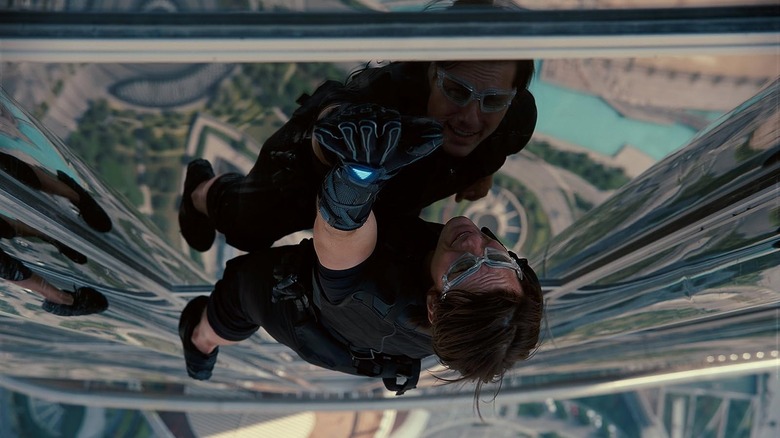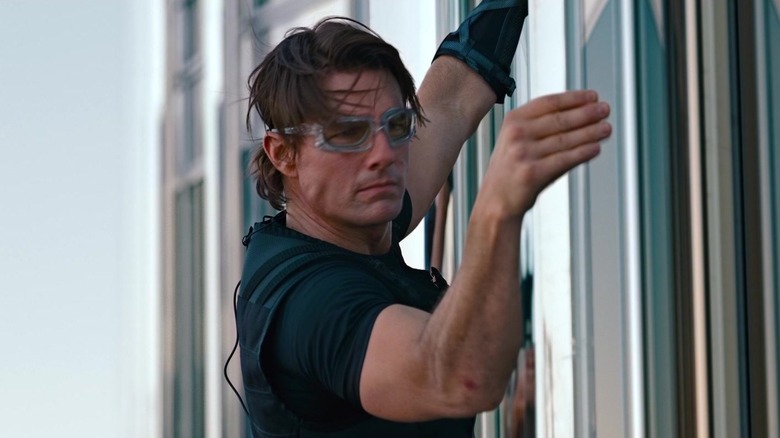Mission: Impossible 4 Took A Major IMAX Risk, But It Paid Off In One Key Scene
"Mission: Impossible — Ghost Protocol" was not the film that turned the "Mission: Impossible" film franchise into the "Tom Cruise Stares Death in the Face" show. No, that honor belongs to "Mission: Impossible II," which opens with Cruise's Ethan Hunt free solo rock climbing in Moab, Utah (which Cruise did for real wearing a harness ... because of course he did). "Ghost Protocol" was, however, a pivotal turning point in the series in terms of both its storytelling and technical elements.
Where director John Woo tried to turn Ethan into an American James Bond with "Mission: Impossible II," director Brad Bird brought the character down to Earth a little in "Ghost Protocol," making him the sort of plucky hero with a knack for evading disaster by the skin of his teeth. Nowhere is this more apparent than in the film's crown jewel — the sequence in which Ethan scales the tallest building in the world, the Burj Khalifa in Dubai, which Cruise did for real wearing cables that were erased digitally in post-production (much like his harness was in "Mission: Impossible II"). This is also arguably the scene that completed Ethan's evolution into a dyed-in-the-wool Buster Keaton-type, as well as the point where the franchise began fully prioritizing huge set pieces and "vibes" over narrative logic.
Not so coincidentally, "Ghost Protocol" received uncredited rewrites by Christopher McQuarrie, who has shepherded the franchise and only doubled down on this approach since then.
Strange as it might sound, Cruise swinging around the outside of a towering skyscraper was, in some ways, less risky than Bird's decision to shoot the sequence with IMAX cameras. In a behind-the-scenes featurette, the film's crew explained just how sensitive the IMAX film stock was and how it easily could've been destroyed while being shipped to the editing room.
'If it gets opened or x-rayed at any point, poof, it's gone'
"We're shooting 65 millimeter, 15 perf," said the film's associate producer, Ben Rosenblatt. "Which is about [holding up hands] that big, each frame. The exposed negative, until it's developed, isn't anything. It's just a chemical reaction. If it gets opened or x-rayed at any point, poof, it's gone."
Transportation was another major concern, as the Burj Khalifa footage couldn't be developed in Dubai. "The whole process of 65 film and shooting IMAX in large format is there's pretty much one place that develops it, and that's in Los Angeles," said production manager/co-producer Tommy Harper. "So we would shoot on Monday in Dubai, we'd wrap the film on Monday night, can it up, put it on a flight Tuesday morning, it'd get to LA on Wednesday, and on Thursday we would have a neg check. So there would be about a four-day lag [from] the moment you shot your film to the moment that you knew your footage was okay."
That risk paid off handsomely. As I can personally attend, this sequence is pretty astonishing looking in a theater, IMAX or otherwise. You actually feel like you're up there with Cruise as he climbs the world's highest skyscraper in "Ghost Protocol," which only adds to the nail-biting tension when complications inevitably arise (especially if, like me, you're not exactly wild about heights in general). Commercially, the outcome was just as rewarding. This sequence made "Ghost Protocol" a must-watch on the largest screen available, with IMAX sales making up nearly a quarter of the film's total opening sales at the box office.
And to think: all of Cruise's death-defying antics might've been undone by nothing more innocuous than someone accidentally opening up the exposed negative on its way around the world.

